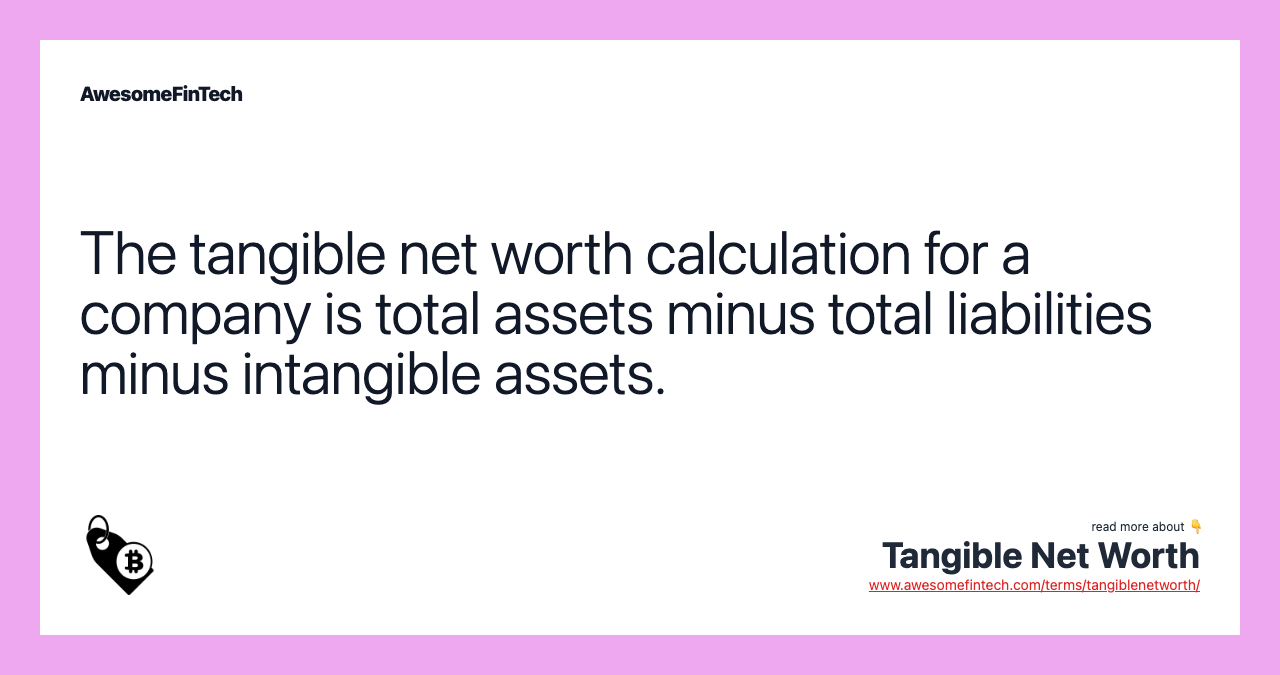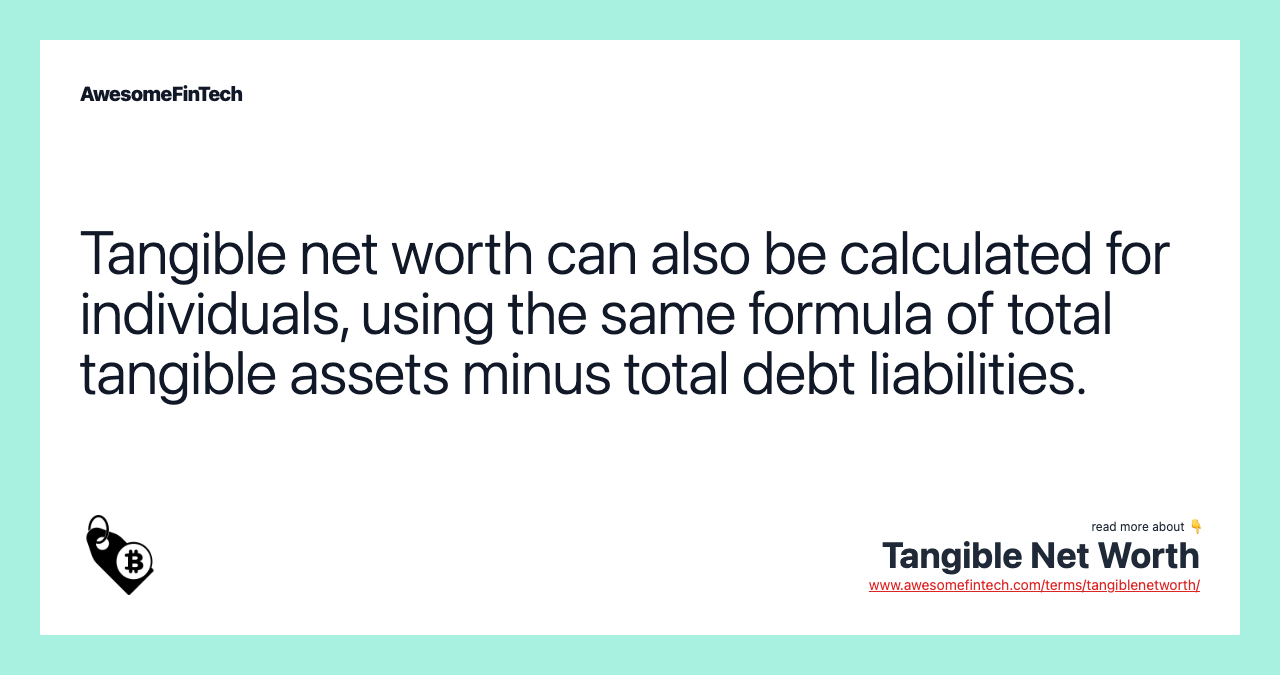Tangible Net Worth
Tangible net worth is most commonly a calculation of the net worth of a company that excludes any value derived from intangible assets such as copyrights, patents, and intellectual property. TNW \= Total Assets − Liabilities − Intangible Assets where: TNW \= Tangible Net Worth \\begin{aligned} &\\text{TNW} = \\text{Total Assets} - \\text{Liabilities} - \\text{Intangible Assets} \\\\ &\\textbf{where:} \\\\ &\\text{TNW} = \\text{Tangible Net Worth} \\\\ \\end{aligned} TNW\=Total Assets−Liabilities−Intangible Assetswhere:TNW\=Tangible Net Worth Tangible net worth is calculated as follows: 1. Locate the company's total assets, total liabilities, and intangible assets, which are all listed on the balance sheet. 2. Take total assets and subtract total liabilities. The primary positive of the tangible net worth calculation is that it is simpler to do than a total net worth calculation, as it is easier to place an accurate value on physical assets than it is to evaluate intangible assets such as customer goodwill or intellectual property. If the value of the property on which a company or individual holds subordinated debt is not sufficient to retire that debt in addition to the debt owed to senior and primary debt holders, then the subordinated debt should not be included in the calculation of tangible net worth. The tangible net worth calculation is designed to represent the total value of a company's physical assets net of its outstanding liabilities, as based on figures shown in the company's balance sheet.

What Is Tangible Net Worth?
Tangible net worth is most commonly a calculation of the net worth of a company that excludes any value derived from intangible assets such as copyrights, patents, and intellectual property.
Tangible net worth for a company is essentially the total value of a company's physical assets. These assets can include:
For an individual, the tangible net worth calculation includes such items as home equity, any other real estate holdings, bank and investment accounts, and major personal assets such as an automobile or jewelry. Relatively insignificant personal assets are not ordinarily included in the calculation for an individual.



Formula and Calculation of Tangible Net Worth
TNW = Total Assets − Liabilities − Intangible Assets where: TNW = Tangible Net Worth \begin{aligned} &\text{TNW} = \text{Total Assets} - \text{Liabilities} - \text{Intangible Assets} \\ &\textbf{where:} \\ &\text{TNW} = \text{Tangible Net Worth} \\ \end{aligned} TNW=Total Assets−Liabilities−Intangible Assetswhere:TNW=Tangible Net Worth
Tangible net worth is calculated as follows:
- Locate the company's total assets, total liabilities, and intangible assets, which are all listed on the balance sheet.
- Take total assets and subtract total liabilities.
- Take the result and subtract intangible assets.
Tangible net worth can also be calculated for individuals, using the same formula of total tangible assets minus total debt liabilities.
What Tangible Net Worth Can Tell You
The tangible net worth calculation is designed to represent the total value of a company's physical assets net of its outstanding liabilities, as based on figures shown in the company's balance sheet. In effect, it indicates an approximation of the liquidation value of the company in the event of bankruptcy or sale.
The primary positive of the tangible net worth calculation is that it is simpler to do than a total net worth calculation, as it is easier to place an accurate value on physical assets than it is to evaluate intangible assets such as customer goodwill or intellectual property. Intellectual property includes things such as proprietary technology or designs.
Tangible net worth is a factor often considered by a lender from whom a company or individual is seeking financing. Typically, banks and creditors will use physical assets of a company to secure a borrowing facility. If the company fails to make payments or defaults, the bank can legally seize the assets. The tangible net worth calculation helps creditors determine the size and terms of the borrowing facility so that they don't lend more than the company's assets are worth.
Limitations of Using Tangible Net Worth
A drawback of using tangible net worth is that it may fall substantially short as a representation of actual net worth in cases where a company or an individual has intangible assets of considerable value. For example, a major computer software firm such as Microsoft Corporation (NASDAQ: MSFT) may possess a wealth of intellectual property rights and other intangible assets that are worth billions of dollars, which would be excluded from the tangible net worth calculation.
One item that can complicate the tangible net worth calculation is subordinated debt, debt that in the event of a default or liquidation is only repaid after all debt obligations to senior debt holders have been satisfied. A simple example of subordinated debt is a secondary mortgage held on real estate.
The secondary mortgage is only repaid after the debt represented by the primary mortgage is paid off. If the value of the property on which a company or individual holds subordinated debt is not sufficient to retire that debt in addition to the debt owed to senior and primary debt holders, then the subordinated debt should not be included in the calculation of tangible net worth.
Related terms:
Accounts Receivable (AR) & Example
Accounts receivable is the balance of money due to a firm for goods or services delivered or used but not yet paid for by customers. read more
Balance Sheet : Formula & Examples
A balance sheet is a financial statement that reports a company's assets, liabilities and shareholder equity at a specific point in time. read more
Bankruptcy
Bankruptcy is a legal proceeding for people or businesses that are unable to repay their outstanding debts. read more
Business Valuation , Methods, & Examples
Business valuation is the process of estimating the value of a business or company. read more
Default
A default happens when a borrower fails to repay a portion or all of a debt, including interest or principal. read more
Equity : Formula, Calculation, & Examples
Equity typically refers to shareholders' equity, which represents the residual value to shareholders after debts and liabilities have been settled. read more
Goodwill : How Is It Used in Investing?
Goodwill is an intangible asset when one company acquires another. It includes reputation, brand, intellectual property, and commercial secrets. read more
Intangible Asset & Example
An intangible asset is an asset that is not physical in nature and can be classified as either indefinite or definite. read more
Intellectual Property
Intellectual property is a set of intangibles owned and legally protected by a company from outside use or implementation without consent. read more
Liquidation
Liquidation is the process of bringing a business to an end and distributing its assets to claimants, which occurs when a company becomes insolvent. read more